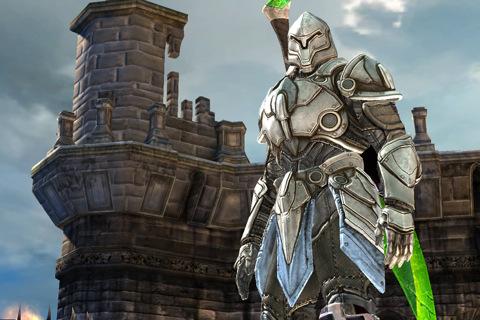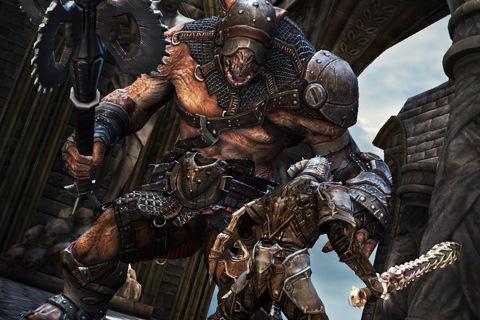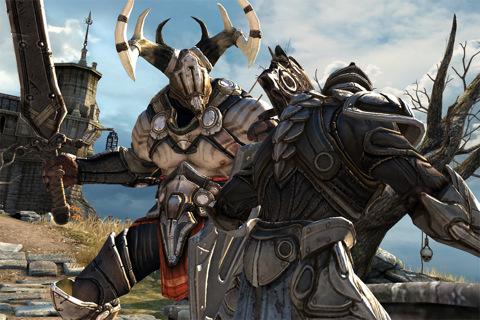- Wondering how to get Monopoly GO! free rolls? Well, you’ve come to the right place. In this guide, we provide you with a bunch of tips and tricks to get some free rolls for the hit new mobile game. We’ll …
Best Roblox Horror Games to Play Right Now – Updated Weekly
By Adele Wilson
Our Best Roblox Horror Games guide features the scariest and most creative experiences to play right now on the platform!The BEST Roblox Games of The Week – Games You Need To Play!
By Sho Roberts
Our feature shares our pick for the Best Roblox Games of the week! With our feature, we guarantee you'll find something new to play!Type Soul Clan Rarity Guide – All Legendary And Common Clans Listed!
By Nathan Ball
Wondering what your odds of rolling a particular Clan are? Wonder no more, with my handy Type Soul Clan Rarity guide.
Infinity Blade Review
With all the buzz about its top notch visuals and its sword and shield action, the last thing I expected to be comparing Infinity Blade to was a Bill Murray movie – but that’s exactly what it is. Beneath its action RPG exterior, heavy metal art style, and massive equipment selection, Chair Entertainment’s first iOS effort is really just Groundhog’s Day in disguise.

Infinity Blade is equal parts Groundhog’s Day, Dragon’s Lair, and finger-numbing action
With all the buzz about its top notch visuals and its sword and shield action, the last thing I expected to be comparing Infinity Blade to was a Bill Murray movie – but that’s exactly what it is. Beneath its action RPG exterior, heavy metal art style, and massive equipment selection, Chair Entertainment’s first iOS effort is really just Groundhog’s Day in disguise.
The story begins with your father attempting to slay the evil God King, only to die by the villain’s treacherous blade. Fast forward 22 years later. You embark on a journey to avenge your father, fight your way through monstrous combatants, and face the man that killed your dear old dad – and the God King guts you like a fish, too. Fast forward 22 years again. Now you’re playing as the son of the hero that was killed on your first play through. This loop continues endlessly until you finally vanquish the God King.
It’s a neat set up for a game, and much to our surprise the experience didn’t feel repetitive on each play through despite offering the exact same layout each time. As you pass through the generations, one son to the next, each inherits the experience and equipment of his father. If you happen to be a level 17 character with a poisonous sword when the God King slays you, you’ll start the son’s life as a level 17 character with a poisonous sword.

The enemies get stronger each generation too, which means that you’ll always be faced with a challenge as you make your way to the God King’s throne. The trick here is that the God King’s level never changes, so while he’s impossible for you to square off against during your first encounter, he’s much more killable by your fourth or fifth.
Slaying monster along the way will earn you experience points which will level you up, but more important than your actual level is the equipment you choose. Each character can equip a weapon, armor, shield, helmet, and magic ring – and each of these pieces of equipment is the basis of your earned experience. When your helmet gets XP, your character gets XP. Each piece of equipment will max out at a certain point, so you’ll want to swap it with new equipment to continue earning XP.
Once you’ve mastered a piece of equipment (full XP) or gone up a level, you’ll earn stat points that can beef up your basics; attack skill, shield strength, magic, and health. You’ll also acquire a good deal of gold both through defeating enemies and keeping a keen eye on the world around you. In turn, you’ll spend this money on a variety of new equipment, each with varied strengths, presenting players with a ton of reason to experiment.
All of this is well and good, but it doesn’t speak to the actual gameplay which, despite what you might have gathered from the screenshots, is surprisingly simplistic. If the story is a medieval twist on Groundhog’s Day, then the gameplay is a 21st century re-imagining of Dragon’s Lair.

While it’s masked by its fast-paced nature, every element of combat amounts to little more than a quick time event. Players don’t actively attack their opponents – instead they’re forced on the defense in every encounter. As an enemy comes in for an attack, players can choose between three different defenses: block, dodge, or parry. There’s varying difficulty between the three tactics (blocking only requires you to press a shield button, while dodging has you tapping in arrow in the correct direction to avoid the attack, and parrying requires a well-timed finger swipe in the right direction) – but each of them breaks down to little more than “wait for the attack, now quickly enter the right command!”
After a few successful defences with the same tactic, your opponent will be stunned and you’ll have a chance to take him down a peg. This will have you wildly swiping back and forth over your intended target, try to do as much damage as possible before he regains his wits. Other elements provide a chance to cause harm, like a super attack that builds up over time, or a magic attack that can be unleashed by drawing a shape on the screen with your fingers. Despite the very QTE nature of combat, things tend to move so lightning fast that you won’t really be bothered by what you know is running under the hood, and instead you’ll be totally lost in a flurry of swipes and taps.

As much as the screenshots speak for themselves, it would be downright impossible to write about Infinity Blade without commenting on its jaw-dropping visuals. This is the first iOS game running Epic’s Unreal Engine, and it’s abundantly clear that they wanted to put every bit of polish they could into making this a showcase for the engine’s potential. Strangely, some sacrifices in the design made us question how well these visuals could run in a more conventional gameplay experience. Rather than navigating the God King’s castle on their own, for example, players have no control over their character’s movement. Could this be a limitation of the software?
With stunning visuals, frantic action, and endless replayability (even after defeating the God King, your progeny will continue to storm the castle), Infinity Blade is easily ranked among the best of the best on the iPhone. Action fans, consider this one a must buy.

The good

The bad
More articles...
Monopoly GO! Free Rolls – Links For Free Dice
By Glen Fox
Wondering how to get Monopoly GO! free rolls? Well, you’ve come to the right place. In this guide, we provide you with a bunch of tips and tricks to get some free rolls for the hit new mobile game. We’ll …Best Roblox Horror Games to Play Right Now – Updated Weekly
By Adele Wilson
Our Best Roblox Horror Games guide features the scariest and most creative experiences to play right now on the platform!The BEST Roblox Games of The Week – Games You Need To Play!
By Sho Roberts
Our feature shares our pick for the Best Roblox Games of the week! With our feature, we guarantee you'll find something new to play!Type Soul Clan Rarity Guide – All Legendary And Common Clans Listed!
By Nathan Ball
Wondering what your odds of rolling a particular Clan are? Wonder no more, with my handy Type Soul Clan Rarity guide.







